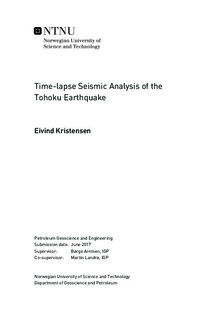Time-lapse Seismic Analysis of the Tohoku Earthquake
Master thesis
Permanent lenke
http://hdl.handle.net/11250/2454371Utgivelsesdato
2017Metadata
Vis full innførselSamlinger
Sammendrag
A time lapse seismic comparison of subsurface movements before and after the 2011 Tohoku earthquake is presented in this report. In order to successfully conduct this comparison, an entire processing sequence from raw data until final time migrated had to be performed. This implied debubbling, frequency correction, common midpoint sorting, muting, velocity anal- ysis, normal moveout correction, stacking and pre-stack time migration. Despite some chal- lenges due to great depths, a satisfying result were obtained. The velocity analysis gave mainly responses as expected, and the normal moveout corrected midpoints confirmed acceptable ve- locity picks, as these appeared as horizontal reflectors.
The work resulted in some clear and significant changes caused by the earthquake. At the shelf, a seabed uplift of 2-3 meters is found. Just east of the trench, on the other hand, an uplift of 20-30 meters is revealed. Hence, the uplift in the areas close to the trench is approximately ten times larger than at the shelf. A significant change in seismic amplitude and reflection pattern after the earthquake are found. As these changes are addressed to either density or velocity changes, a comparison between the two lines using the same velocity model is implemented. This is done in order to isolate the changes, trying to distinguish which physical parameters causing the ob- served differences. The majority of the observed time-lapse effects were still present when the same velocity model were used on both sections, indicating that density changes are the main reason for these changes. Several examples of re-opening of faults, change in dip angle and new orientation of sedimentary layers were also found.
